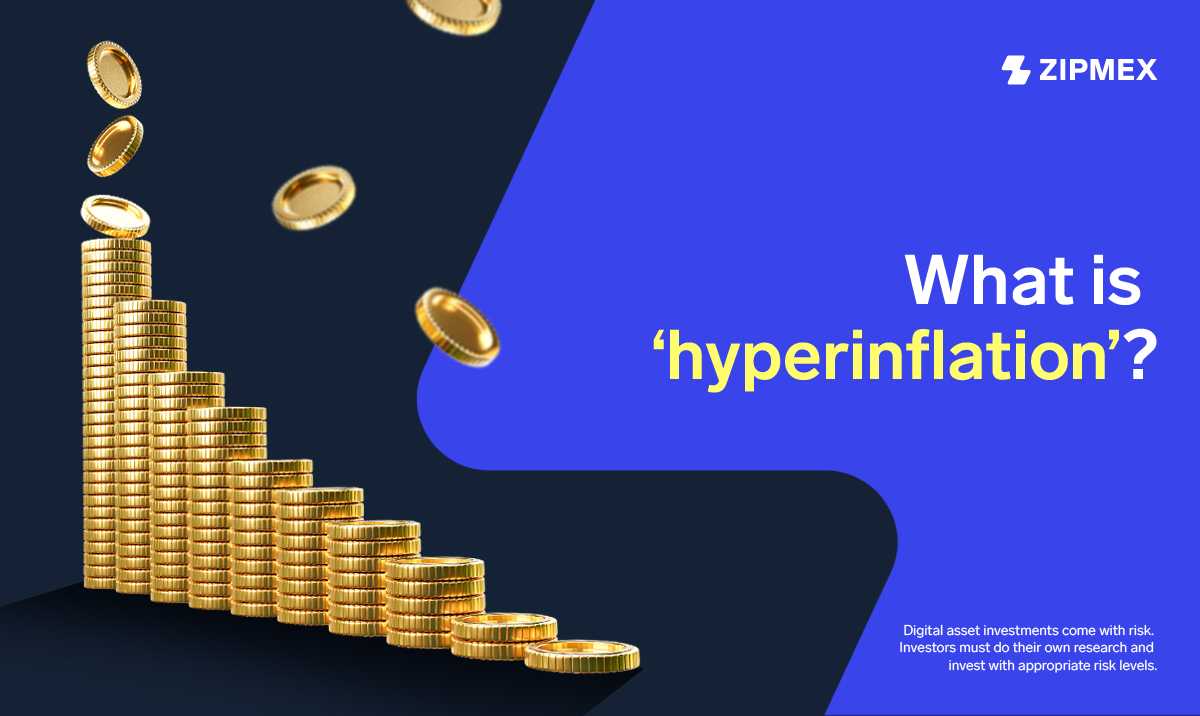Throughout 2022, many countries worldwide have encountered hyperinflation significantly, such as Venezuela, Argentina, Turkey, Zimbabwe, Islamic Republic of Iran, Yemen, etc., with the inflation rate over 2 digits or more. Besides, many more countries are also at risk of hyperinflation in the future, for example, Haiti, Ethiopia, and Angola.
When hyperinflation occurs, people will start hoarding consumption products like bread, milk, or groceries resulting in products’ price rise as the demand is higher. Moreover, people will lose their savings because of their inclined value. Everything mentioned will definitely shake the whole economy in the big picture and as well affect the investment market including cryptocurrency.
What is hyperinflation?
Short answer: Hyperinflation occurs when the inflation rate, or price level, rapidly rises over 50% monthly. Read more about inflation here.
Hyperinflation is a term to describe the rapid growth of the price which cannot be controlled by the economy. Some may confuse hyperinflation with stagflation and inflation, but hyperinflation only occurs when the inflation rate hikes over 50% each month. It can also be indicated by other factors, e.g. the 3-year cumulative rate of inflation that rises over 100%.
Stagflation: An economic event when stagnation – low economic activities -, and inflation occur at the same time.
What causes hyperinflation?
There are two main causes of hyperinflation as follows:
- Money supply
- Demand-pull inflation: supply shortage pulls prices up.
We have seen some examples of hyperinflation in the past before. Most of the major inflation incidents were the consequence of the government producing more money into the system.
That resulted in a higher inflation rate due to a higher volume of money, causing product prices to rise as the demand was higher than the supply like a domino effect.
As money supply and demand-pull inflation occurred at the same time from newly added money in the system, the product prices kept soaring. The rising consumer product prices made people believe that the inflation rate wouldn’t lower any soon. Therefore, they hoarded to avoid the future cost resulting in higher market demand which, of course, caused a shortage of goods and even higher inflation rates.
Hyperinflation factors
There are several factors that can cause hyperinflation such as high domestic debt, less export income, less economic productivity, and product shortage from the price control policy. In addition, there is also a factor related to the lack of political, government, and economic reliability. This factor was well evident during the spread of Covid-19. Many countries had to face heavy inflation which later became hyperinflation.
With the factors mentioned above combined with Russia and Ukraine conflict, the gas price increased which worsened the inflation situation even more. The effect spread around the world, especially in oil-importing countries. On the other hand, oil-exporting countries did not face the same complication. Thus, we can say that the gas price issue was caused by geopolitics.
The effects of hyperinflation
Here are the effects caused by hyperinflation
The effects on individuals
Hyperinflation may cause product shortages. Consumers may start hoarding various kinds of products starting with the durable type like vehicles or electronics, followed by groceries.
The money’s value declines as the product prices hike, thereby, consumers are required to pay more for the same amount of goods, aka “the decrease of purchasing power.” This includes higher electricity and water bills.
The effects on financial institutions
Hyperinflation rapidly decreases the value of the currencies on the trading market. As a result, domestic currency holders reduce the amount of their holdings and switch to more stable foreign currencies.
During hyperinflation, people usually choose to save their money by themselves without depositing it in banks or financial institutions. Consequently, those financial organizations will be at high risk of bankruptcy due to liquidity issues as their credit loan products lose their value. Besides, the financial institutions won’t have enough operating funds because of the lack of customers’ deposits.
The effects on the economy and the country overall
Hyperinflation will reduce the country’s imports as the product prices abroad get higher. In addition, the unemployment rate will skyrocket because more businesses and companies have to close down due to the unfavorable economy. People and business owners won’t be able to stand the tax burden, which will result in lower taxation. As a consequence, the government will gain less income to develop the country. However, if the government decides to produce more money into the economic system, the hyperinflation situation can get even worse.
Examples of hyperinflation worldwide
The image above is based on IMF (International Monetary Fund)’s prediction stating the inflation rate each country will gain in 2022 using colors. The countries with a darker shade of red means a higher inflation rate they will gain (or higher than 50%), e.g, Venezuela and Turkey. Let’s learn how Hyperinflation happens and its causes from these two examples.
Hyperinflation in Venezuela
The inflation rate in Venezuela had slowly risen since 2013, and the country’s started facing Hyperinflation in 2015 onward. Venezuela has been in the inflation cycle for over 4 years which doesn’t seem to end any soon, as the country’s central bank announced a 690% inflation rate in December 2021. It rocketed to 3000% in 2020 in the span of 4 years with over 50% increased inflation rate per month. It is considered the longest hyperinflation period in history.
There are several factors that cause hyperinflation in Venezuela. One of them is the extreme populist projects from the politicians who were desperate to gain their votes. They encouraged people to stop farming and enter importing businesses instead. Apart from that, the government would offer to build houses for the citizens at a lower price which means the private firms couldn’t compete with the undercut.
Moreover, the government also announced money exchange rate control to prevent money from flowing abroad. The policy caused a severe foreign currency shortage. Besides, the price control policy was enforced to limit the price ceiling to be lower than reality. Hence, the private firms were at a loss, so they switched to importing products instead.
Later in 2014 – 2016, there was an oil price crisis in the country. The oil price dropped from US$ 100/barrel to below 30 US$ 30/barrel, resulting in a great loss. However, the government continued the populist policies and had to take more loans from China and Russia. Venezuela’s national oil company was at loss and lost its trust in the government’s efficiency.
Nevertheless, the government still produced more money into the system in the hope to solve the country’s problems, unfortunately, it increased the inflation rate even more. The rising inflation rate directly affected the exchange rate causing the imported items to be more expensive. Bolivar currency became as worthless as a piece of paper. The image above of two men sewing bags with Bolivar banknotes proves that the sentence isn’t exaggerated.
Until now, Venezuela is still the country with the highest inflation rate in the world.
Hyperinflation in Turkey
Turkey is the next country IMF predicts the inflation rate to be as high as 60.1% (Hyperinflation) in 2022. The main reasons are the spread of Covid-19, and the Ukraine, and Russia conflict in the Black Sea region. The conflict affects Turkey directly because Russia is the country’s main energy resource, while Ukraine is the country’s wheat supplier. Plus, Turkey’s tourism has relied heavily on Russian tourists. Another reason is Turkey has a high country’s debt, and recently Turkish lira has lost considerable value against the US dollar.
All of the factors mentioned pushed the product prices up, but the wages remained the same. Agricultural production was also affected by much higher costs it wasn’t profitable, which led to a large number of agricultural product imports. Turkey’s prime minister, with a great intention to fix the inflation rate, launched a policy to reduce the country’s interest rate which was opposite to economic theory 101: Inflation can be controlled by increasing the interest rate.
Turkey’s transport sector’s price inflated the most in April 2022 with a 105.9% inflation rate, while food and beverage’, excluding alcohol, rose to 89.1%. Though the government decreased taxation on some types of products and partly helped with household electricity costs, it couldn’t stop the inflation. Recently, Turkey has reset its ties with Saudi Arabia, and that might be the big economic stimulus Turkey was waiting for.
Long story short, hyperinflation can be caused by many factors, such as accumulated issues due to external factors. Political policies can as well trigger hyperinflation. However, inflation in some countries may only occur temporality.
Disclaimer: The information provided in this article is not intended to provide investment or financial advice. Investment decisions should be based on the individual’s financial needs, objectives, and risk profile. We encourage readers to understand the assets and risks before making any investment entirely.

